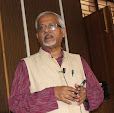
A huge rush of devotees had converged at the confluence of Ganga, Yamuna and mythical Saraswati from the wee hours of Tuesday-Wednesday night. The best period of the shnan (bathing) for Makar Sankranti was between 4.30am and 9am.
CJ: Arindam Roy , 14 Jan 2009 Views:296 Comments:0
AS THE sun moved into the summer solstice on Wednesday (Jan 14), 20 lakh pilgrims bathed in Triveni Sangam, on the occasion of Makar Sankranti. No untoward incidents were reported during the second important bathing day of the six-week fair, the annual Magh Mela, according to the district magistrate Rajeev Aggarwal.
A huge rush of devotees had converged at the confluence of Ganga, Yamuna and mythical Saraswati from the wee hours of Tuesday-Wednesday night. The best period of the shnan (bathing) was between 4.30am and 9am, according to Alok Tripathi, a devout who has been bathing in Sangam for last 14 odd years.
The annual Magh (which coincides with the Hindu month), began on Magh Purnima (Jan 11). The arrangements are thorough and foolproof, as it is often likened to a mini Kumbh Mela, said a mela official, talking to merinews.
Pilgrims had started arriving for the Sankranti bathing, at the Mela area, from Tuesday (Jan 13). They came in tractors, bullock carts and trolley rickshaws. Some from nearby places walked slowly. The Sangam area had a colourful look, as people of various age groups rubbed shoulders and walked slowly. While some groups sang kirtans, others raised the cry, ‘Har Har Gangey’, ‘Ganga Mai ki Jai’, as they trudged along to the river banks.
Rekha Devi, a young mother, dragged her two half asleep children, at the Sangam Nose, at 4.30 am. Her son, who was barely eight years old, protested more than his sister. She appeared to be a couple of years elder to him. Rekha had some flowers and change of clothes in a plastic shopping bag. She was not interested in talking. I heard her children’s loud wail, as they were dragged into the Sangam waters. Soon, a wave of pilgrims arrived and I lost Rekha and her two children in the maddening crowd.
An old couple, in their eighties, was walking slowly to the river, aided by their sons and grandsons. The entire family was deeply concerned about the elders. They were asking the impossible crowd to give them a little way.
When the crowd parted, it seemed no less a miracle than the parting of the sea by Moses. All this was seen at about 6 am, the same day. A poor, childless widow, Suggi, in her seventies, told me that she had saved a fistful of grains from her daily meals, for years. The small savings that she generated, each day, year after year, helped her attend the fair this year.
It is interesting to see a temporary township spring up. It’s made of bamboo, tins and tents. Rows of shops and wayside vendors lend to the colour and mood of this vibrant fair, which is as old as Vedas, said Rahul Pandey, a Sanskrit scholar.
The entire Mela area has been subdivided into several sectors, with a sector magistrate looking after each sector. The district magistrate Aggarwal, who is also the Mela Adhikari, is heading the team of meal officials.
By Wednesday evening, the administration heaved a sigh of relief, as there were unconfirmed reports of a possible terrorist attack, according to a section of the media.
( http://www.merinews.com/catFull.jsp?articleID=156293 )












No comments:
Post a Comment